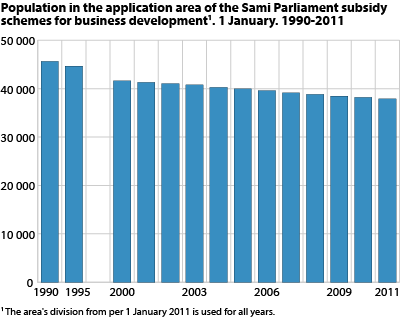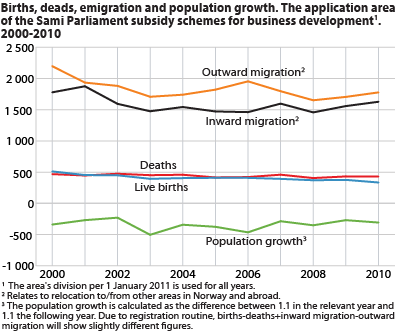Content
Published:
This is an archived release.
Sami in Norway
The Sami are an indigenous people who live in Norway, Sweden, Finland and Russia. Because there is no overall registration of the Sami population, no one knows exactly how many Sami there are today. The Sami are scattered throughout the country, but the most concentrated Sami settlement areas are north of Saltfjellet.
The report Sami statistics 2012 presents statistics that are relevant to Sami society in Norway. The statistics have a primarily geographical approach, with emphasis on Sami settlement areas north of the Saltfjellet mountain range, which lies on the Arctic Circle. The area is called the area of the Sami Parliament subsidy schemes for business development. The report contains statistics about Sami Parliament elections, population, education, Sami language in kindergarten and school, income, employment, reindeer herding, agriculture and fishing.
Data sourcesBecause there is no overall registration of the Sami population, it is difficult to generate statistics on the Sami as a group. The statistics here have been drawn up based on the geographic range for the application area of the Sami Parliament subsidy schemes for business development. The Sami population south of Saltfjellet is not included in the statistics since the Sami settlement here is so spread out that areas with Sami settlements are not regarded as Sami local communities, and it would be difficult to create geographically-based statistics from this. One result of such a geographic division is that persons within the application area of the Sami Parliament subsidy schemes for business development that do not regard themselves as Sami are included in the statistics. Correspondingly, Sami who live outside the application area of the Sami Parliament subsidy schemes for business development are not included. |
Falling population in the outskirts
The application area of the Sami Parliament subsidy schemes for business development accounts for around 50 per cent of the area in Norway north of Saltfjellet, but has only 10 per cent of the population. Only 4 per cent live in densely populated regions. In the rest of the area north of Saltfjellet, 96 per cent of the population lives in densely populated areas. This is on the outskirts of Norway north of Saltfjellet, which is defined as a Sami settlement area. All the towns and larger communities are outside the application area of the Sami Parliament subsidy schemes for business development.
As of 1 January 2011, 37 900 persons were in the application area of Sami Parliament subsidy schemes for business development. The population has decreased by 17 per cent since 1990. Every year more people move out of the area than to the area. While most of those who move out of the area are young, the area has an older population than the rest of the country, with a higher number of people aged 50 years or more than the rest of the country.
Fertility among women in the application area of the Sami Parliament subsidy schemes for business development was higher than for women in the rest of the country until 2002, since when it has been lower in six of the eight years.
Life expectancy is somewhat lower for both sexes in the application area of the Sami Parliament subsidy schemes for business development than for the whole country. A girl born in the application area of the Sami Parliament subsidy schemes for business development can expect to live until she reaches 81.6 years, and a boy 77.0 years. For the country as a whole, the figures are 83.2 years and 78.9 years respectively. Life expectancy is also lower than the rest of the area north of Saltfjellet.
Education level
Around four out of five persons in the application area of the Sami Parliament subsidy schemes for business development are educated to the equivalent of compulsory schooling or upper secondary level. The level of education is lower than for other areas north of Saltfjellet and in the rest of the country.
Native language
While the number of pupils with Sami as their 1st language is stable, the number of pupils with Sami as their 2nd language has decreased substantially in recent years, with a 38 per cent decrease since 2005.
Employment
Sixty-four per cent of persons aged 15-74 years in the application area of the Sami Parliament subsidy schemes for business development are in employment. This figure is somewhat lower than for the rest of the area north of Saltfjellet. The majority of the men work in wholesale and retail trade, hotels and restaurants, while the majority of women work in health and social services.
There are almost as many women as men in reindeer herding. Seven out of ten persons who are connected to reindeer herding live in the application area of the Sami Parliament subsidy schemes for business development. Most of them live in Finnmark county.
Tables:
- Table 1 Population at 1 January, births, deaths and migration. STN area total
- Table 2 Highest education completed for persons aged 16 years and over at 1 October, by gender and area. 1990-2010. Per cent
- Table 3 Persons in employment aged 15-74 years, by gender and industry. Norway North of Saltfjellet. 4th quarter
Contact
-
Anders Sønstebø
E-mail: anders.sonstebo@ssb.no
tel.: (+47) 46 66 37 74
-
Christian Sørlien Molstad
E-mail: christian.molstad@ssb.no
tel.: (+47) 46 65 99 12
-
Statistics Norway's Information Centre
E-mail: informasjon@ssb.no
tel.: (+47) 21 09 46 42




